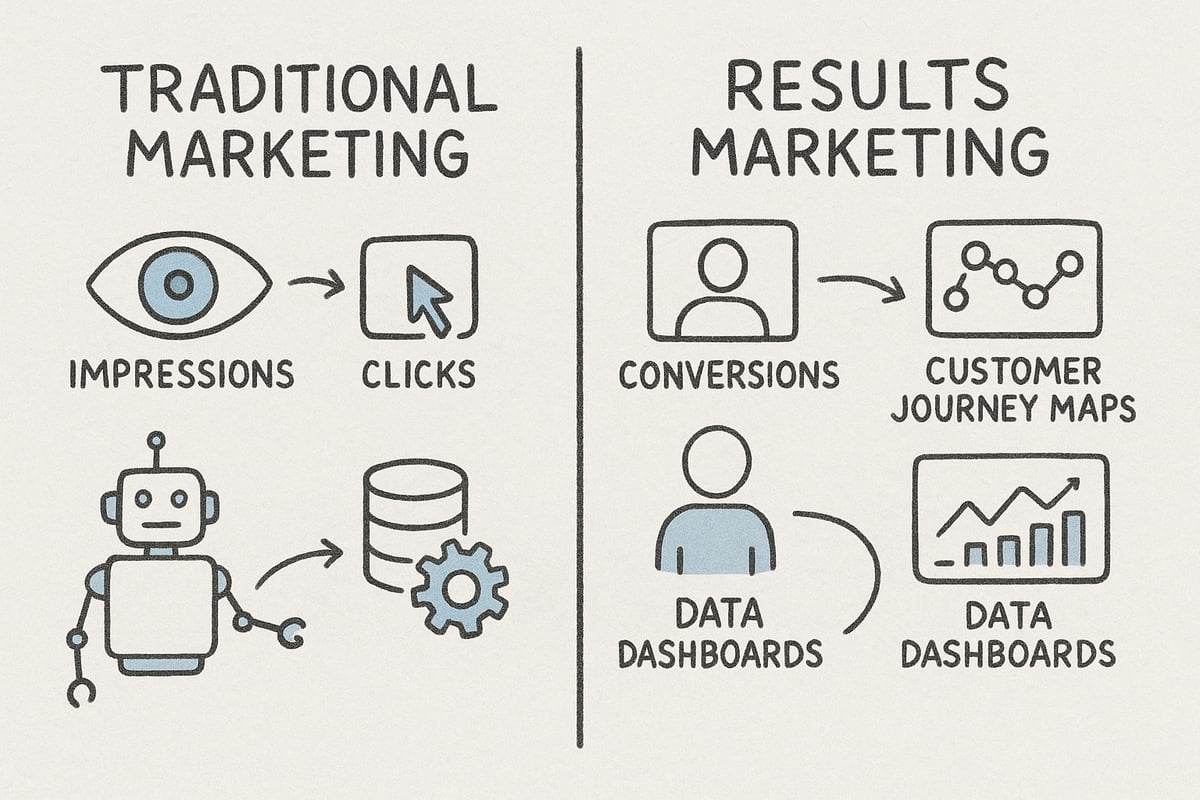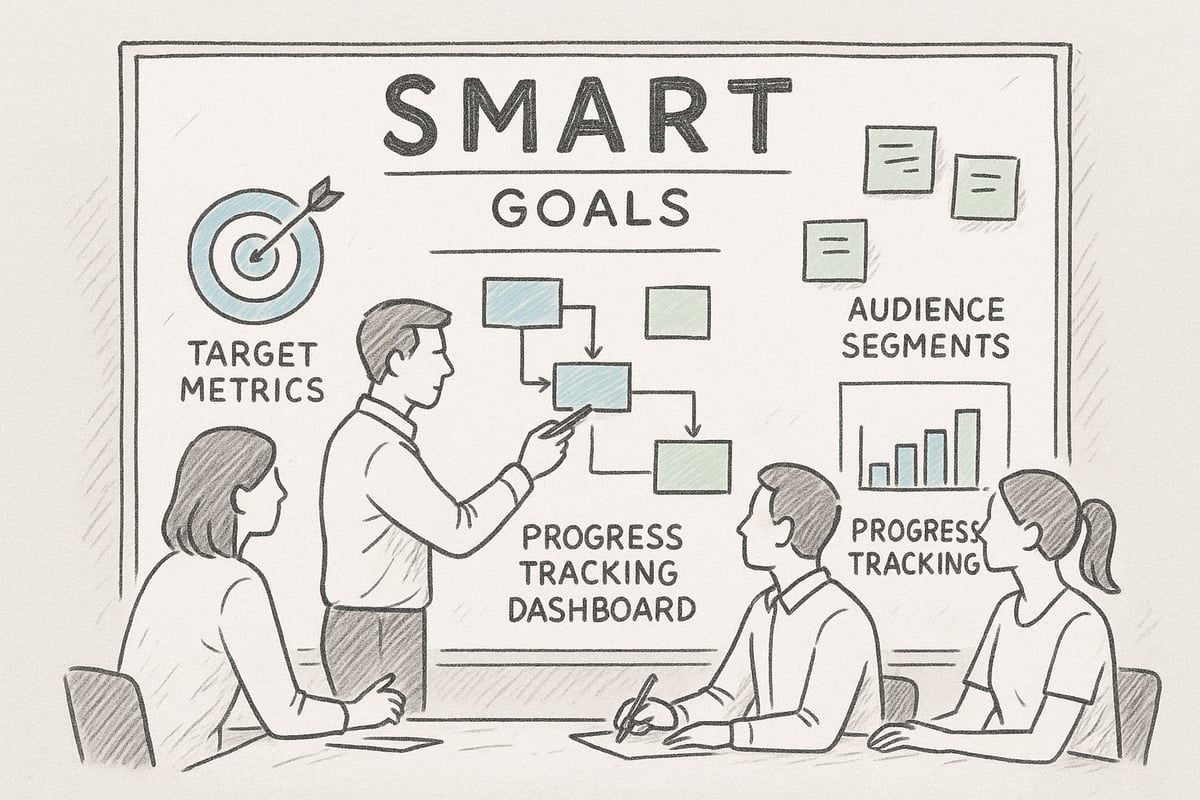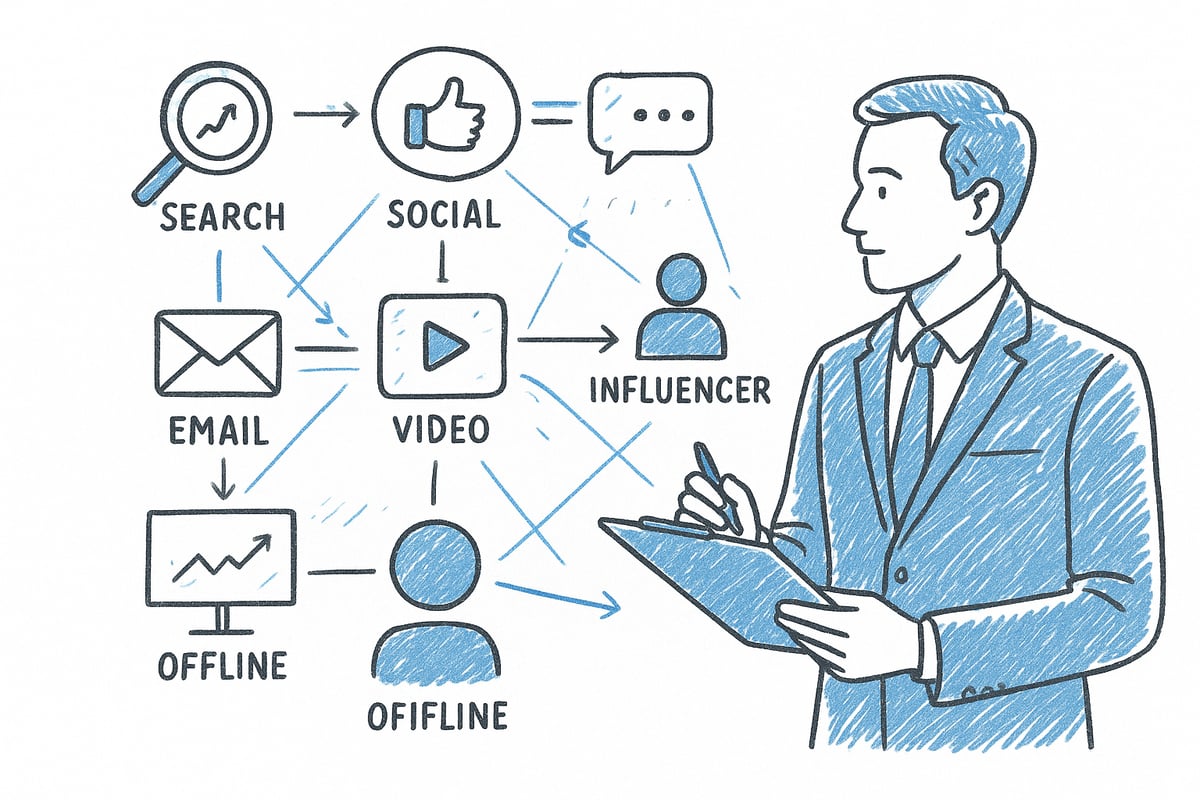The digital marketing landscape is transforming at lightning speed, with brands facing increasing pressure to deliver measurable impact. As competition intensifies and technology advances, results marketing has become essential for organizations seeking to stand out and drive real growth.
This guide offers a comprehensive roadmap to mastering results marketing in 2025. You will discover actionable strategies, proven frameworks, and practical steps designed to help you achieve measurable outcomes and maximize return on investment.
Inside, we break down the essentials: what defines results marketing, how to set clear goals, the power of data-driven tactics, choosing the right channels, ongoing optimization, and the trends shaping the future.
Ready to elevate your marketing approach? Dive in for expert insights and practical guidance that will help you outperform the competition and achieve results that matter.
Understanding Results Marketing in 2025
The landscape of results marketing in 2025 is defined by a relentless focus on measurable outcomes and strategic growth. Marketers can no longer rely on surface-level metrics or generic approaches. Instead, success depends on a deep understanding of what drives real business value and how to align every tactic with clear, data-backed goals.

Defining Results Marketing
Results marketing in 2025 centers on outcomes, not just activities. Unlike traditional marketing, which often prioritized reach and impressions, results marketing emphasizes real business impact. The difference is clear: traditional campaigns might celebrate high ad impressions, while results marketing tracks how those impressions turn into conversions and long-term customer value.
| Traditional Marketing | Results Marketing |
|---|---|
| Impressions | Conversions |
| Clicks | Customer LTV |
| Brand Awareness | Retention Rate |
This evolution means modern teams must measure what truly matters.
Key Metrics and KPIs
To drive results marketing, teams focus on essential metrics such as conversion rate, return on investment (ROI), customer acquisition cost (CAC), lifetime value (LTV), and retention rate. These indicators provide a comprehensive view of performance across both digital and offline channels.
KPIs have evolved to reflect changing consumer behaviors and technology adoption. For example, Statista reported that 72% of marketers identified ROI as their top KPI in 2024. By tracking the right metrics, marketers ensure their strategies deliver tangible business outcomes.
The Role of Customer-Centricity
Customer experience is the heart of results marketing. In 2025, personalization and journey mapping are not optional—they are expected. Marketers use detailed personas and behavioral data to deliver tailored experiences at every touchpoint.
Salesforce research shows that 88% of customers now expect personalized interactions. By putting the customer first, brands can increase engagement, loyalty, and ultimately, marketing results. Understanding the full customer journey allows teams to identify opportunities for deeper connections.
Technology and Automation
The rise of AI, machine learning, and automation tools has transformed results marketing. Marketers leverage martech stacks to track, analyze, and optimize every campaign in real time. Automation enables teams to scale efforts, reduce manual work, and target audiences with precision.
According to HubSpot, 61% of marketers now use AI to improve campaign outcomes. For a deeper dive into how artificial intelligence is driving measurable marketing results, explore AI for marketing strategies. Embracing these technologies is essential for staying competitive in a rapidly changing environment.
Common Challenges and Pitfalls
Despite advancements, results marketing faces common challenges. Data silos, attribution issues, and internal resistance to change can hinder progress. Many teams still struggle to integrate data sources, with Gartner reporting 45% of marketers facing this obstacle in 2023.
Another pitfall is focusing on vanity metrics instead of true performance indicators. To avoid these traps, marketers must prioritize transparency, align metrics with business goals, and foster a culture of continuous learning.
Step 1: Setting Measurable Marketing Goals
Setting measurable marketing goals is the first step toward effective results marketing. Without clear targets, even the most creative campaigns can fall short. To drive meaningful outcomes in today's competitive environment, marketers must set structured, data-driven goals that connect directly to business growth.

Importance of SMART Goals
The SMART framework guides marketers to create goals that are Specific, Measurable, Achievable, Relevant, and Time-bound. This structure ensures that every objective is clear and actionable, which is essential for results marketing.
By defining what success looks like up front, teams can align efforts and resources efficiently. Research shows companies with well-defined goals are 376% more likely to report marketing success. Setting SMART goals is not just a best practice, it is a non-negotiable for consistent results marketing.
Aligning Goals with Business Objectives
For results marketing to deliver real value, marketing goals must align tightly with business objectives. If a company’s goal is to increase revenue, marketing should focus on qualified lead generation or customer retention.
This alignment ensures that every marketing activity supports the bigger picture. For example, connecting lead generation campaigns directly to sales targets creates a seamless path from marketing investment to business impact. Results marketing thrives when objectives are connected across departments.
Audience and Market Research
Effective results marketing starts with understanding your audience. Segmentation and persona development allow marketers to target the right people with the right message. Using market research, teams can identify key demographics, behaviors, and pain points.
According to Marketing Statistics: 100+ Insights for 2025, accurate audience targeting is more critical than ever for campaign success. Comprehensive research helps ensure that marketing goals are both relevant and achievable within the chosen market segment.
Competitive Benchmarking
Benchmarking against competitors helps set realistic marketing goals. By analyzing industry leaders, marketers can identify gaps and opportunities for differentiation. Tools like SEMrush or industry reports provide data on average conversion rates, customer acquisition costs, and engagement metrics.
Results marketing relies on this external perspective to avoid setting goals in a vacuum. Understanding where your brand stands in relation to competitors helps calibrate expectations and track progress effectively.
Setting Short-term vs. Long-term Goals
A balanced approach to results marketing requires both short-term wins and long-term growth strategies. Short-term goals might focus on campaign-specific KPIs such as click-through rates, while long-term objectives support brand equity and customer loyalty.
For instance, a brand may run a seasonal campaign to boost immediate sales, while simultaneously investing in content marketing to build long-term authority. Results marketing is most effective when there is harmony between these timelines.
Tracking Progress and Iterating
Regularly reviewing performance against goals is crucial in results marketing. Dashboards and analytics platforms provide real-time insights, enabling teams to adapt quickly.
Iterative processes, such as monthly check-ins and quarterly reviews, help refine strategies based on what works. By monitoring progress and being willing to pivot, marketers maximize their chances of achieving measurable results.
Step 2: Data-Driven Marketing Strategies
Adopting data-driven marketing strategies is crucial for achieving consistent growth in results marketing. By leveraging data, marketers can make informed decisions, enhance personalization, and optimize campaigns for measurable outcomes. In 2025, integrating advanced analytics, automation, and AI is no longer optional but essential for staying competitive.

Building a Data Infrastructure
A robust data infrastructure forms the backbone of results marketing. Centralized data platforms like Customer Data Platforms (CDPs) and Customer Relationship Management (CRM) systems allow marketers to gather, unify, and analyze information from multiple sources.
To ensure trustworthy insights, data quality, privacy, and compliance with regulations such as GDPR and CCPA are non-negotiable. Without clean, compliant data, even the most sophisticated strategies will fall short. According to Forrester, 70% of marketers prioritize data quality in their operations.
Building a solid foundation enables marketers to track and optimize every stage of the customer journey.
Attribution Models and Analytics
Attribution models are fundamental to evaluating the effectiveness of results marketing campaigns. These models determine how credit for conversions is assigned across different touchpoints, helping marketers understand what drives success.
Common models include:
- First-touch attribution
- Last-touch attribution
- Multi-touch attribution
Selecting the right model depends on your business goals and customer journey complexity. With the rise of Google Analytics 4, businesses now benefit from more flexible and granular attribution capabilities. Accurate attribution empowers marketers to allocate resources effectively and maximize ROI.
Personalization and Segmentation
Personalization is at the heart of results marketing in 2025. Using data, marketers can segment audiences based on demographics, behaviors, and preferences to deliver highly relevant messages.
Dynamic content adapts to user actions, increasing engagement and conversions. For example, Epsilon found that 80% of consumers are more likely to buy from brands offering personalized experiences.
Effective segmentation and personalization not only improve campaign performance but also foster customer loyalty and retention.
Predictive Analytics and AI
Predictive analytics and AI are transforming how marketers approach results marketing. By analyzing historical data and patterns, AI tools forecast trends, predict customer behaviors, and suggest optimal actions.
Popular applications include:
- Lead scoring
- Churn prediction
- Dynamic pricing
According to Deloitte, 60% of marketers plan to increase AI investments in 2025. For a deeper dive into how AI is reshaping digital marketing, explore AI in digital marketing. Embracing predictive analytics gives brands a competitive edge by anticipating market shifts and customer needs.
Real-Time Optimization
Real-time optimization allows marketers to adjust campaigns instantly based on live data. This agility is essential for results marketing, where rapid response can significantly impact performance.
Key benefits include:
- Increased conversion rates
- Reduced wasted spend
- Improved customer experience
By monitoring analytics dashboards and applying swift changes, marketing teams can capitalize on opportunities and address issues as they arise. Agile marketing practices are particularly effective in today's fast-paced environment.
Case Study: Data-Driven Success
Consider a retail brand that implemented an integrated data platform to unify online and offline customer data. By leveraging results marketing strategies, they identified high-value segments, personalized offers, and optimized ad spend in real time.
The outcome? A 35% increase in ROI and a notable boost in customer retention. Key lessons include the importance of clean data, the power of predictive analytics, and the continuous refinement of strategies.
Data-driven approaches empower brands to achieve measurable, repeatable results.
Step 3: Channel Selection and Integration
Selecting and integrating the right marketing channels is a pivotal step in achieving success with results marketing. In 2025, the landscape is more fragmented and dynamic than ever, making a structured approach essential for driving measurable outcomes.

Evaluating Marketing Channels in 2025
The choices for reaching audiences are expanding. Top-performing channels now include search, social media, email, influencer marketing, video, and offline methods. Each channel offers unique strengths for results marketing.
Here’s a comparison of popular channels:
| Channel | Strengths | 2025 Trend |
|---|---|---|
| Search | High intent, measurable ROI | Growing |
| Social Media | Broad reach, engagement | Diversifying |
| Personalization, retention | Stable | |
| Influencer | Trust, niche audiences | Rising |
| Video | Visual storytelling, recall | Accelerating |
| Offline | Tangible touchpoints | Integrating digitally |
According to 2025 Marketing Statistics, Trends & Data, marketers are increasingly blending digital and offline efforts for greater impact. For results marketing, understanding where your audience is most active and aligning channels with strategic goals is fundamental.
Omnichannel vs. Multichannel Strategies
Deciding between omnichannel and multichannel approaches is critical. Multichannel means using multiple channels independently, while omnichannel integrates them to create a seamless customer journey.
Brands that master omnichannel strategies in results marketing see higher engagement and retention. For example, companies with omnichannel experiences retain 89 percent of their customers, compared to single-channel approaches.
To implement omnichannel:
- Map customer touchpoints across channels
- Ensure messaging consistency
- Use unified data for personalization
This holistic integration supports stronger, measurable outcomes.
Cross-Channel Attribution and Measurement
Measuring performance across channels is a cornerstone of results marketing. Cross-channel attribution models help marketers understand which channels contribute most to conversions and ROI.
Common attribution methods include:
- First-touch attribution
- Last-touch attribution
- Multi-touch attribution
Using unified reporting tools, marketers can visualize the customer journey and optimize spend. Accurate attribution ensures credit is given where due, supporting better decision-making and higher performance.
Integrating Online and Offline Efforts
Blending online and offline channels is a growing priority in results marketing. Retailers, for example, use QR codes in-store to connect physical shoppers with digital offers and loyalty programs.
Effective integration tips:
- Sync campaign messaging and branding
- Track offline actions with digital analytics
- Use events and pop-ups to drive online engagement
Bridging these worlds delivers a cohesive experience, increasing the likelihood of conversions and long-term loyalty.
Budget Allocation and Resource Planning
Smart budget allocation is essential for results marketing. Data-driven planning helps marketers invest in channels with the highest potential ROI.
Key steps include:
- Analyzing past performance data
- Forecasting channel returns
- Allocating resources based on strategic priorities
According to recent surveys, marketers are shifting budgets toward digital-first channels while maintaining flexibility to pivot as trends change. This approach maximizes efficiency and impact.
Channel Testing and Experimentation
Continuous testing is vital for optimizing channel mix in results marketing. Techniques like A/B testing and multivariate experiments reveal what works best for different audiences.
Case studies show that brands willing to pivot channels based on test results often achieve higher ROI and faster growth. Key practices include:
- Running controlled experiments
- Measuring outcomes in real time
- Iterating based on insights
A culture of experimentation ensures your channel strategy remains agile and results-focused.
Step 4: Optimizing Campaigns for Maximum Results
Optimization is the engine that drives results marketing to its full potential. Once your campaigns are running, continuous refinement separates average performance from industry-leading ROI. In this section, we explore the frameworks, tools, and best practices that ensure your marketing efforts consistently deliver measurable outcomes.
Continuous Improvement Frameworks
Successful results marketing depends on structured, repeatable frameworks for campaign optimization. Two industry standards are PDCA (Plan, Do, Check, Act) and agile marketing cycles. PDCA encourages marketers to plan strategies, execute campaigns, review results, and refine tactics in a continuous loop.
Agile marketing emphasizes short sprints, rapid feedback, and iterative testing. These approaches promote flexibility and adaptability in the fast-changing digital landscape. For a deeper dive into structured optimization, see Marketing processes and optimization.
By embedding these frameworks into your workflow, you foster a culture of ongoing improvement and accountability in results marketing.
Creative and Messaging Optimization
Creative assets and messaging are pivotal in capturing audience attention and driving conversions in results marketing. Regular testing of headlines, visuals, and calls to action (CTAs) uncovers what resonates best with your target audience.
A/B and multivariate testing help identify high-performing combinations. Brands often see a 30 percent increase in click-through rates after systematic creative testing. Keep your messaging aligned with brand values while adapting to audience feedback.
Review campaign analytics to determine which creative elements drive engagement. Consistent optimization ensures your content remains fresh, relevant, and effective.
Conversion Rate Optimization (CRO)
Conversion Rate Optimization is at the heart of results marketing. It focuses on removing barriers that prevent users from taking desired actions, such as filling out a form or completing a purchase.
Key CRO tactics include:
- Streamlining landing page layouts
- Simplifying forms
- Enhancing checkout processes
Utilize tools like Hotjar, Optimizely, and Google Optimize to collect user insights and test changes. For more strategies, refer to Marketing processes and optimization.
Continuous experimentation with page elements can significantly improve conversion rates and overall campaign performance.
Automation and Workflow Efficiency
Marketing automation is essential for maximizing efficiency in results marketing. Automated workflows ensure routine tasks, such as email sends and lead scoring, are executed without manual intervention.
Top benefits include:
- Time savings for strategic work
- Consistent campaign execution
- Enhanced segmentation and targeting
According to HubSpot, marketers save more than six hours per week using automation. Explore Data-driven marketing automation to discover tools and techniques that drive optimization.
Integrating automation into your campaigns frees up resources and enables faster, data-driven decision-making.
Performance Monitoring and Reporting
Robust performance monitoring is crucial for results marketing success. Dashboards and analytics platforms provide real-time visibility into key metrics, such as conversion rates, ROI, and customer acquisition cost.
Establish a regular reporting cadence to track progress and identify areas for improvement. Actionable insights from data analysis help you pivot strategies quickly when needed.
Transparent reporting also fosters alignment across teams, ensuring everyone is focused on measurable outcomes.
Learning from Failures and Successes
Every campaign in results marketing offers valuable learning opportunities. Post-mortem analyses help teams understand why certain tactics worked or underperformed.
Document both failures and wins, and share insights across your organization. Key lessons often lead to innovative ideas and prevent repeated mistakes.
Encourage a culture of experimentation, where teams are empowered to test, analyze, and iterate. This mindset drives continuous improvement and long-term marketing success.
Future Trends and Innovations in Results Marketing
Staying ahead in results marketing means keeping a close eye on emerging trends and innovations. As 2025 approaches, marketers face a wave of new technologies and shifting consumer expectations. Let us explore the forces shaping the future of results marketing, from AI to ethical branding.
AI and Machine Learning Advancements
Artificial intelligence is rapidly transforming the results marketing landscape. In 2025, marketers rely on AI-driven tools for campaign automation, audience segmentation, and real-time analytics. Machine learning models predict consumer behavior, optimize ad spend, and personalize content at scale.
Generative AI is making content creation faster and more tailored. Marketers can now use AI to draft emails, design visuals, and adjust campaigns instantly based on live data. For a deeper look at how new tech will impact results marketing, check out the 6 Marketing Trends to Look Out for in 2025.
As AI adoption grows, teams gain a competitive edge by leveraging predictive analytics and automation. This shift ensures results marketing stays both efficient and effective.
Privacy and Data Regulation Changes
Data privacy is at the forefront of results marketing strategies. With updates to GDPR and CCPA on the horizon, marketers must navigate stricter regulations. These changes require transparent data collection and increased consumer consent.
Personalization remains vital, but balancing it with privacy is now essential. Brands are investing in secure data management and ethical practices to build trust. As privacy laws evolve, adapting quickly is key for results marketing success.
Voice, Visual, and Interactive Search
The search landscape is evolving. By 2025, voice and visual search will play a central role in how consumers discover brands. Voice assistants and image-based queries are becoming everyday tools.
According to industry reports, up to 50% of searches could be voice-based by 2025. Marketers are optimizing content for conversational queries and enhancing visuals for search engines. To understand how consumer behaviors are shifting, explore Marketing Trends 2025 – 5 Consumer Trends to Watch.
Interactive search, such as quizzes and live chat, also shapes the future of results marketing. These innovations help brands engage audiences and drive measurable outcomes.
Sustainability and Ethical Marketing
Sustainability is no longer optional in results marketing. Consumers increasingly favor brands that demonstrate environmental and social responsibility. Ethical marketing practices, like transparent sourcing and eco-friendly packaging, influence buying decisions.
In 2025, marketers integrate ESG (Environmental, Social, Governance) factors into every campaign. Highlighting sustainable initiatives builds loyalty and sets brands apart. Results marketing now measures not just profit, but also positive impact on society and the planet.
Preparing for the Unknown
The only certainty in results marketing is change. Agile teams are essential for navigating disruption and seizing new opportunities. Marketers must experiment, learn quickly, and adapt to emerging trends.
Building resilience means fostering a culture of innovation. Teams that embrace rapid learning and flexible strategies will thrive, even when faced with unexpected challenges. By staying proactive, marketers ensure their results marketing efforts remain strong, no matter what the future brings.
